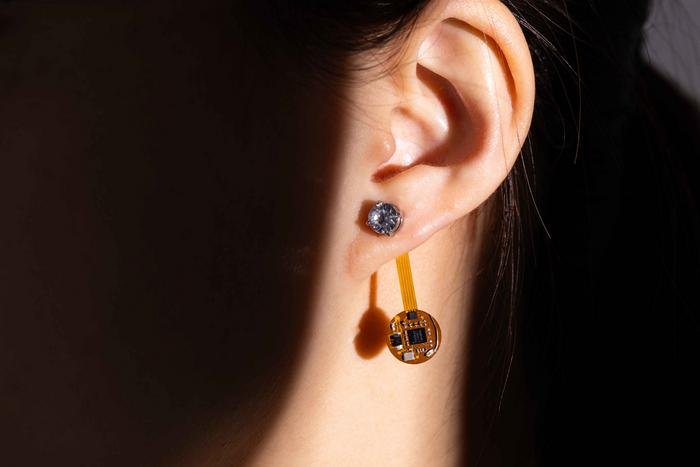University of Washington (UW) researchers have developed a pair of thermal, wireless smart earrings designed to monitor numerous health parameters.
The high-tech jewelry not only outperformed a smartwatch in sensing resting skin temperature, but the researchers say it may be adapted to monitor signs of stress and fever, track eating and exercise, and even monitor for signs of ovulation.
“I wear a smartwatch to track my personal health, but I’ve found that a lot of people think smartwatches are unfashionable or bulky and uncomfortable,” said co-lead author Qiuyue (Shirley) Xue, a UW doctoral student in the Paul G. Allen School of Computer Science & Engineering. “I also like to wear earrings, so we started thinking about what unique things we can get from the earlobe.”
Those musings led Xue to the idea of creating smart earrings that could monitor the temperature of the human body when in direct contact with the earlobe. The researchers also realized that the dangling design of some earrings could enhance that data with readings from outside the body.
“We found that sensing the skin temperature on the lobe, instead of a hand or wrist, was much more accurate,” Xue explained. “It also gave us the option to have part of the sensor dangle to separate ambient room temperature from skin temperature.”
Being able to compare the skin temperature to the ambient temperature could provide these theoretical smart earrings with the ability to determine if the wearer is running a fever, has an unhealthily low body temperature or is simply affected by their surroundings.
Building the Smart Earrings
Soon Xue’s team set about building a prototype of their smart earrings. But almost immediately, they recognized the challenges of creating something light enough to wear, something robust enough to gather useful data, and something long-lasting enough so that it didn’t need to be constantly charged.
“It’s a tricky balance,” said co-lead author Yujia (Nancy) Liu, who was a UW master’s student in the electrical and computer engineering department when doing the research and is now at the University of California San Diego. “Typically, if you want power to last longer, you should have a bigger battery. But then you sacrifice size. Making it wireless also demands more energy.”
After some initial designs, their completed version, whose designs are published in the journal Proceedings of the ACM on Interactive Mobile Wearable and Ubiquitous Technologies, is about the size of a paperclip, includes a Bluetooth chip for communication, a rechargeable battery, and two separate temperature sensors. The smart earrings also boast a 28-day battery life thanks to an ingenious wireless communication method.
“Instead of pairing it with a device, which uses more power, the earring uses Bluetooth advertising mode — the transmissions a device broadcasts to show it can be paired,” the researchers explain. “After reading and sending the temperature, it goes into deep sleep to save power.”
To perform its “smart” functions, the device’s temperature sensor is held against the ear by an opposing magnet. At the same time, the dangling part contains a separate sensor that measures the room’s ambient temperature. These two readings, the researchers say, can offer significant insights into the wearer’s health and well-being.
Numerous Potential Applications for Smart Earrings
One potential application for the device involves more accurate monitoring of fevers. Toward that end, the researchers monitored the earlobe temperature of 20 healthy patients and five patients with fevers throughout the day. The results showed a profound discrepancy between the daily temperatures of healthy patients and the sick ones, “suggesting the earring’s potential for continuous fever monitoring.”
“In medicine, we often monitor fevers to assess response to therapy — to see, for instance, if an antibiotic is working on an infection,” said co-author Dr. Mastafa Springston, a clinical instructor at the Department of Emergency Medicine in the UW School of Medicine. “Longer term monitoring is a way to increase sensitivity of capturing fevers since they can rise and fall throughout the day.”
Along with the potential for monitoring exercise and stress patterns via small changes in body temperature, the researchers also say there is one particularly useful function their smart earrings may accomplish that a smartwatch simply cannot perform: tracking ovulation.
“Current wearables like Apple Watch and Fitbit have temperature sensors, but they provide only an average temperature for the day, and their temperature readings from wrists and hands are too noisy to track ovulation,” Xue said. “So we wanted to explore unique applications for the earring, especially applications that might be attractive to women and anyone who cares about fashion.”
Future Jewelry Set Could Perform Advanced Health Monitoring
While the current prototype is not yet commercially available, the researchers behind its creation say it can have its appearance personalized with customized resin shapes like a flower or adorned with a particular gemstone without adversely affecting the accuracy of its temperature detection.
In future designs, the researchers say they will look into adapting the smart earrings to run on solar power or even kinetic energy generated by the jewelry’s own swaying. They also hope to look into other jewelry options that can work in concert with the smart earrings to perform all kinds of medical analyses.
“Eventually, I want to develop a jewelry set for health monitoring,” Xue said. “The earrings would sense activity and health metrics such as temperature and heart rate, while a necklace might serve as an electrocardiogram monitor for more effective heart health data.”
Christopher Plain is a Science Fiction and Fantasy novelist and Head Science Writer at The Debrief. Follow and connect with him on X, learn about his books at plainfiction.com, or email him directly at christopher@thedebrief.org.

